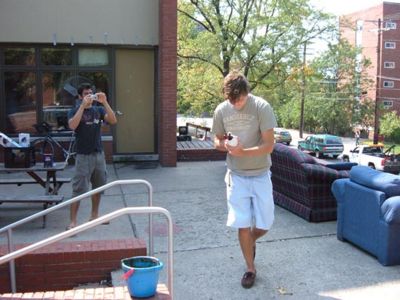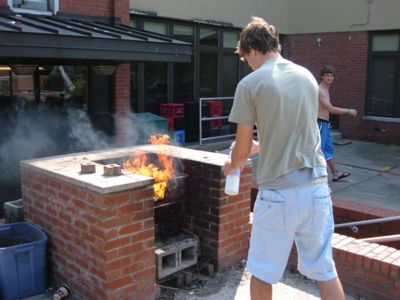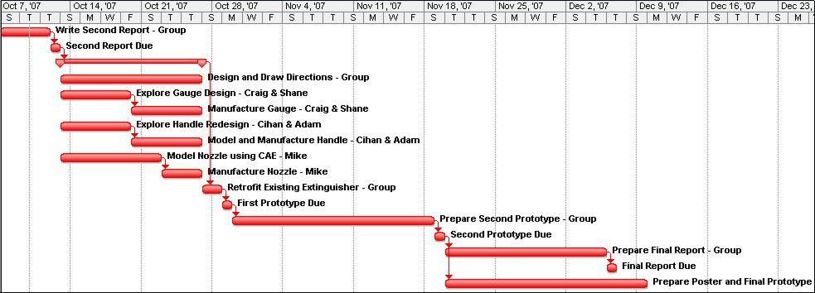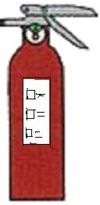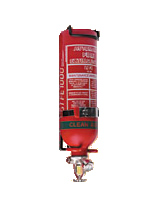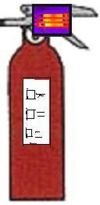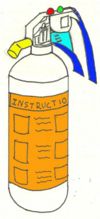Fire extinguisher redesign
From DDL Wiki
Contents |
Market Research
Live Trials
In order to better understand how people use a fire extinguisher, we set up a trial in which we observed a person attempting to extinguish a grease fire. The fire was set up in a brick grill for safety purposes, and was created with used grease from a kitchen.
The subject, who had never used a fire extinguisher, was told to put out the fire, and received no additional help or instructions.
He first picked up the extinguisher, and pulled the pin while walking over to the fire. He took a quick look at the label as he adjusted his grip. He stood about 5 feet away and pushed the handle down, but the extinguisher did not discharge. After further examination, he realized that the pressure gauge showed that the extinguisher was empty. While it was not empty, it was not pressurized either. While the gauge correctly showed this, the user did not look at the gauge.
We set the trial up again with another extinguisher. This time the subject looked at the gauge while walking over to the fire and gripped the extinguisher correctly from the start. He saw that it was full and proceeded accordingly. Again he stood about 5 feet from the fire and pushed down on the handle. He sprayed the extinguisher for 1-2 seconds at the fire and then stopped, as it looked like the fire was out. He stepped closer to look through the cloud of dry chemical from the extinguisher. However, the fire flared back up again a few seconds. He again discharged the extinguisher for a 1-2 second burst. This repeated a few times as the fire kept flaring after each 1-2 second blast. Eventually, with a little encouragement, the subject discharged the remains of the extinguisher from a safe distance.
After the experiment, we interviewed the subject about his fire extinguishing experience. We took into account his responses as well as our observations and came up with the following key problems to address:
- 1) User does not always look at pressure gauge
- 2) User only looked at the pictorial instructions
- 3) User did not discharge entire extinguisher
- 4) User did not always aim at base of fire
- 5) User moved too close to fire
- 6) User initially did not grip extinguisher correctly.
It is important to note that many of these problems could be avoided if the user reads the instructions listed on the extinguisher. However, most of the instructions are printed in very small text. The user only looked at the pictures, which highlight the most important instructions.
Firefighters Interview
Station 14 – Pittsburgh Fire Department Interview & Insight
On the 26th of September, the design team took a trip to fire station 14, located in South Oakland, to interview the crew on their knowledge of problems surrounding fire extinguishers and household fires. Relevant findings include:
1. Smoke inhalation is the leading cause of death and injury in household fires.
2. Most common causes of household fire is carelessness (candles, cigarette butts, stovetop grease, ect.)
3. Most common misuses include not aiming at the base of fire, not applying enough extinguishing agent to fully suppress the fire, and not calling the fire department before they attempt to extinguish it themselves.
Timeline
The following Gantt chart shows our expected timeline and plans for progress over the next two months. As goals and expectations develop, the chart will be updated to reflect these changes.
The text to the right of each task explains both the nature of the task and the members who will be completing the task. All entries marked “group” will be worked on by the whole group or will be broken down and assigned to individual group members at a later date.
Design Choices
Pugh Chart
As the chart indicates, the first two of our design choices are relatively similar when compared to the original product, while the final design choice was quite an improvement. Consequently this will be the design we shall endeavor to create.
In looking at all of our choices, we took six categories into account: Safety, Reliability, Ease of Operation, Cost, Impact upon other Objects, and Aesthetics.
For the Automated Fire extinguisher, the most beneficial feature came from ease of operation. Since it is unmanned there is nothing that the user has to do. In addition, the chemicals are designed to be safe for kitchen and home appliances. However, these benefits are countered by the fact that it is an extremely costly product, almost 7x the original product. In addition, the safety and reliability are compromised by the possibility of failure to discharge. Failure to discharge would completely counter the purpose of the extinguisher. Ultimately, we found the automated fire extinguisher to be equally comparable, as a product, to the standard fire extinguisher.
Looking at the Thermal Fire Extinguisher, it has all of the same benefits of the original design, with a thermal imaging LCD attached so that the user can view where the fire is through the smoke. The safety of the device is increased due to the fact that the user does not have to waste valuable time in waiting for visibility to increase before continuing to discharge the extinguisher. In addition, the aesthetics are improved by the visual aid. However, in looking at the negative aspects, we see that the thermal extinguisher when compared to the original is much worse for cost. Most of the other factors remain the same. Ultimately, we found this extinguisher to be a slight improvement on the original design, due to the ability of the thermal sensor to show the user exactly where to continue aiming at the fire.
Finally, our last concept design, the Fire Extinguisher 2 turned out to be a great improvement upon the original. Safety, ease of use, reliability, and aesthetics are all improved by the addition of the ratcheting system, new handle, and most importantly the increased instruction legibility. In addition, the nozzle pointed downward and made rectangular aides in the user’s initial response to the fire. The only negative comes with the increase cost, but this doesn’t severely affect the comparison.
In conclusion, we feel that the design for the Fire Extinguisher 2.0 is the choice we will pursue.
Final Design Selection
The design team's proposed redesign consists of five key features meant to improve the function, usability, and reliability of the product. The redesigned or added components are all aimed at addressing certain issues found to be problematic to the consumer and user during the market research phase of development. The newly designed fire extinguisher will be more intuitive, easier to operate, and more reliable than the previously existing design.
The first feature tagged for redesign is the instruction label (denoted with orange). While the current one does tell you all the information you need to know for proper operation, it does not present some important directions in a large, noticeable, and recognizable form. Many important instructions that are currently in fine print will be made larger and in pictorial form, utilizing a larger amount of the canister area. Also, the directions will be placed on the side of the fire extinguisher facing the user, so that he or she may refer to them while using the device if necessary.
The second feature to be modified is the trigger mechanism (dark blue). Instead of the current thumb operated trigger design, the fire extinguisher 2.0 will incorporate a more intuitive gun trigger squeeze operated mechanism. Problems were identified during live trials where the user did not instinctively know how to release the chemical agent. By using a squeeze trigger, the user should more easily be able to identify the proper hand placement. Additionally, this trigger design will reduce the amount of force required to release the dry chemical, thereby making operation easier for weaker individuals.
Incorporated with the trigger redesign is a ratchet mechanism (light blue) designed to force the user to discharge all the extinguishing agent on the fire. A very common problem when dealing with household fires is that the user discharges the chemical agent until the flames disappear. Unfortunately, the flames often re-ignite, causing the user to discharge another small batch of extinguishing agent. The problem is that this method is very ineffective in extinguishing fires. The objective of the chemical agent is to smother the fire. By using small doses, the fire is given oxygen to re-ignite. The fire extinguisher is intended to be used in its entirety, thereby smothering the flames for a long enough period of time to completely stop the burn. The ratchet will lock the handle in the valve-open position once squeezed.
Another issue to be addressed is the fact that most unexperienced users won't aim at the base of the fire as prescribed by the instructions. This may be due to lack of visibility of the flames because of smoke or just because of ignorance. To improve the ease of use, we will pre-angle the nozzle downward, to compensate for high aiming individuals. Also, we have decided that a square nozzle will provide a more beneficial spray, covering more area.
The last, and perhaps the most complicated, redesign will be the addition of an LED pressure gauge. The current analog gauge is not very recognizable to the user, so to improve this, we are implementing a red light green light system on top of the extinguisher for optimal visibility. The hope is that if the extinguisher is empty, for whatever reason, that the user will now be able to recognize this immediately and take appropriate action.
Links
Further information on the existing model can be found at Fire extinguisher
Acknowledgments
Prepared for: 24-441 Engineering Design Course (Fall 2007), Carnegie Mellon University
By Michael Rem, Shane McGuire, Cihan Kadipasaoglu, Adam Haag, Craig Cramer
